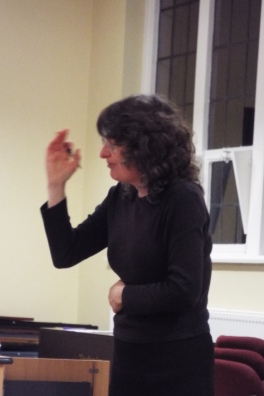Dr Stella Fletcher opened her fascinating October lecture on ‘The Borgia Through Time’ by asking a provocative question:
Why are all the novels and plays about the Borgia?
- Alexander VI wasn’t the first pope to recognise his children
- Nor the first to play one family off against another
- And he wasn’t the first to arrange marriages between lay kinsmen and ruling families
So why does all the attention focus on Alexander?
- He was not the first pope to make serious effort to control Papal States and their vicars
- Nor the first to hold a jubilee
- He was certainly not the first to promote his kinsmen because they all did it.
- He was not even the first Catalan speaking pope.
So what made the Borgia stand out?
 Three main characters populated Dr Fletcher’s lecture: Pope Alexander VI (elected in 1492); his illegitimate son, Cesare, Duke of Valentinois; and Lucretia, Alexander’s daughter. Another important person was another son – the Duke of Gandia – Juan or Giovanni. He was murdered and his body thrown in the Tiber. His killer was never identified, not least because there were many people with grudges. The Pope refused to blame various people who’d been identified as possible culprits, which suggested that he knew who had commited the murder but wouldn’t say for political reasons. Cesare comes into the frame because he benefited from Juan’s death and rumours that he was responsible for the murder surfaced 9 months later. This led people to wonder whether the pope abandoned the search for Juan’s murderer because it was his own son?
Three main characters populated Dr Fletcher’s lecture: Pope Alexander VI (elected in 1492); his illegitimate son, Cesare, Duke of Valentinois; and Lucretia, Alexander’s daughter. Another important person was another son – the Duke of Gandia – Juan or Giovanni. He was murdered and his body thrown in the Tiber. His killer was never identified, not least because there were many people with grudges. The Pope refused to blame various people who’d been identified as possible culprits, which suggested that he knew who had commited the murder but wouldn’t say for political reasons. Cesare comes into the frame because he benefited from Juan’s death and rumours that he was responsible for the murder surfaced 9 months later. This led people to wonder whether the pope abandoned the search for Juan’s murderer because it was his own son?
 Dr Fletcher then examined the story’s cultural journey from actual history to myth, and in doing so, she provided the audience with a fascinating glimpse into the way history reflects the time in which it was written. The blackening of the Borgia name began with the election of Pope Julius II. Italians were xenophobic and resented foreigners, and Naples was invaded – Italy was being used as a battlefield by other powers. Stories circulated that Alexander’s election was a result of a pact with the devil. Protestants lapped this up and spread the tale. One of the principal agents in this was the English printer, John Bale, who wrote his Pageant of the Popes in 1550. Now the Pope was equated with the Devil.
Dr Fletcher then examined the story’s cultural journey from actual history to myth, and in doing so, she provided the audience with a fascinating glimpse into the way history reflects the time in which it was written. The blackening of the Borgia name began with the election of Pope Julius II. Italians were xenophobic and resented foreigners, and Naples was invaded – Italy was being used as a battlefield by other powers. Stories circulated that Alexander’s election was a result of a pact with the devil. Protestants lapped this up and spread the tale. One of the principal agents in this was the English printer, John Bale, who wrote his Pageant of the Popes in 1550. Now the Pope was equated with the Devil.
Attention moved from Alexander to Cesare in the mid-seventeenth century, with the first publication of Machiavelli’s The Prince in English translation. The response to Titus Oates and the popish plots led to Cesar Borgia: a tragedy, which turned out not to be the way to impress the patron, James duke of York, who was Catholic. There were lots of anti-Catholic jibes in the play.

In 1800, Byron saw the love letters to Lucretia and declared them to be the ‘prettiest ever written’. By this stage there was interest in why there was a woman in the Vatican. As there wasn’t a lot to say, they invented stories laden with suspect morals. Even the efforts of the Unitarian William Roscoe couldn’t resue her reputation. He came to Italian Renaissance history through poetry and found a discrepancy in poetic accounts of Lucretia. Although he took the positive view of her, her bad reputation was still too strong. Victor Hugo’s imagination ran wild – despite his claims to have read various sources there is no evidence of it in the text he wrote. Attributes various poisonings to her without any evidence. Hugo’s version of events was was hugely influential.
From 1905 the Borgia took a popular turn, which was unsurprising in the cinematic age, then in the 21st Century, Mario Puzzo (creator of the godfather) wrote ‘The Family’, portraying the Borgia as the earliest mafia. They even appear in the video game, Assassin’s Creed III. Dr Fletcher concluded that the graphic violence of these recent contributions to the historiography of the Borgia are a reflection of our post-Christian society more than theirs.




